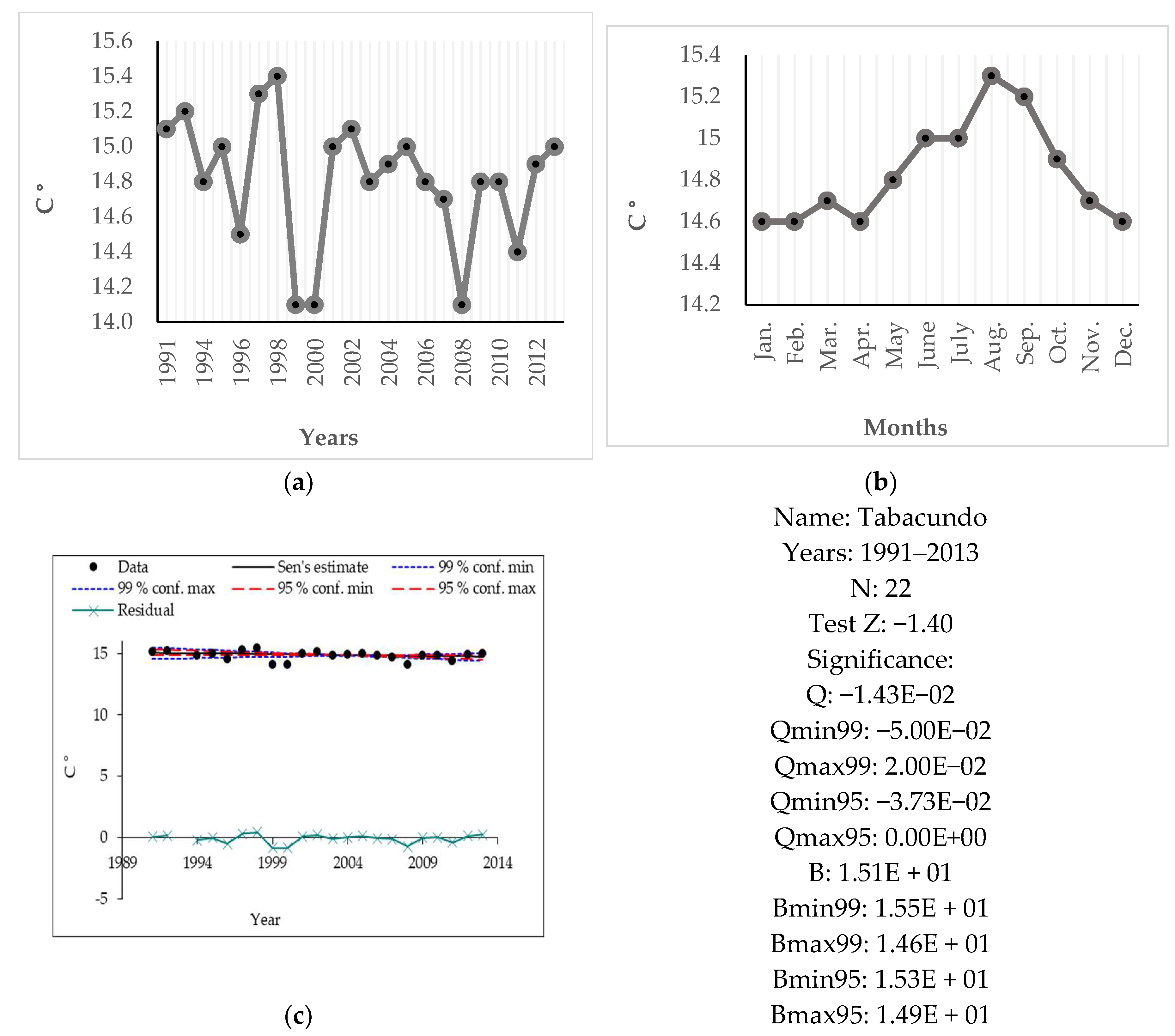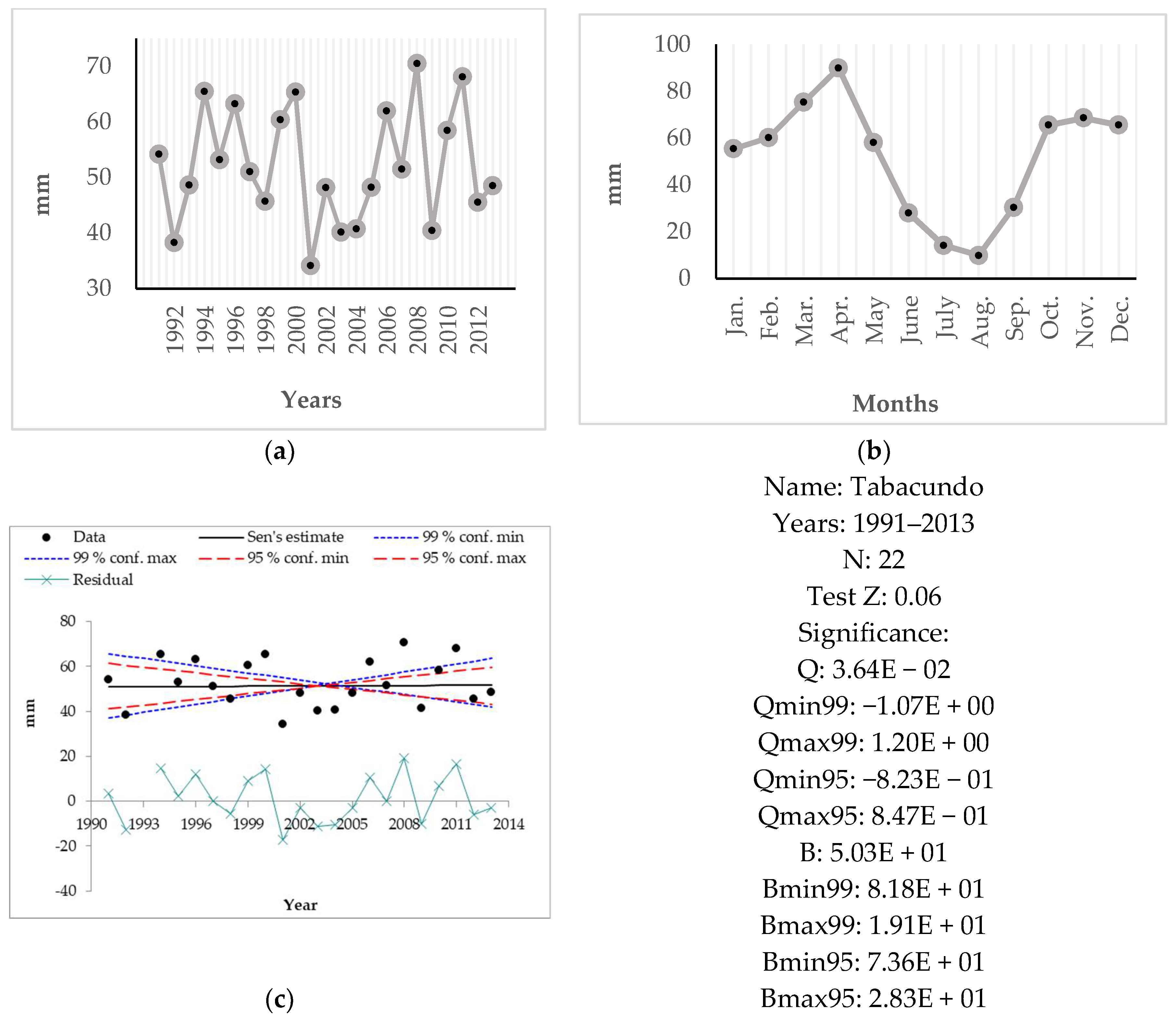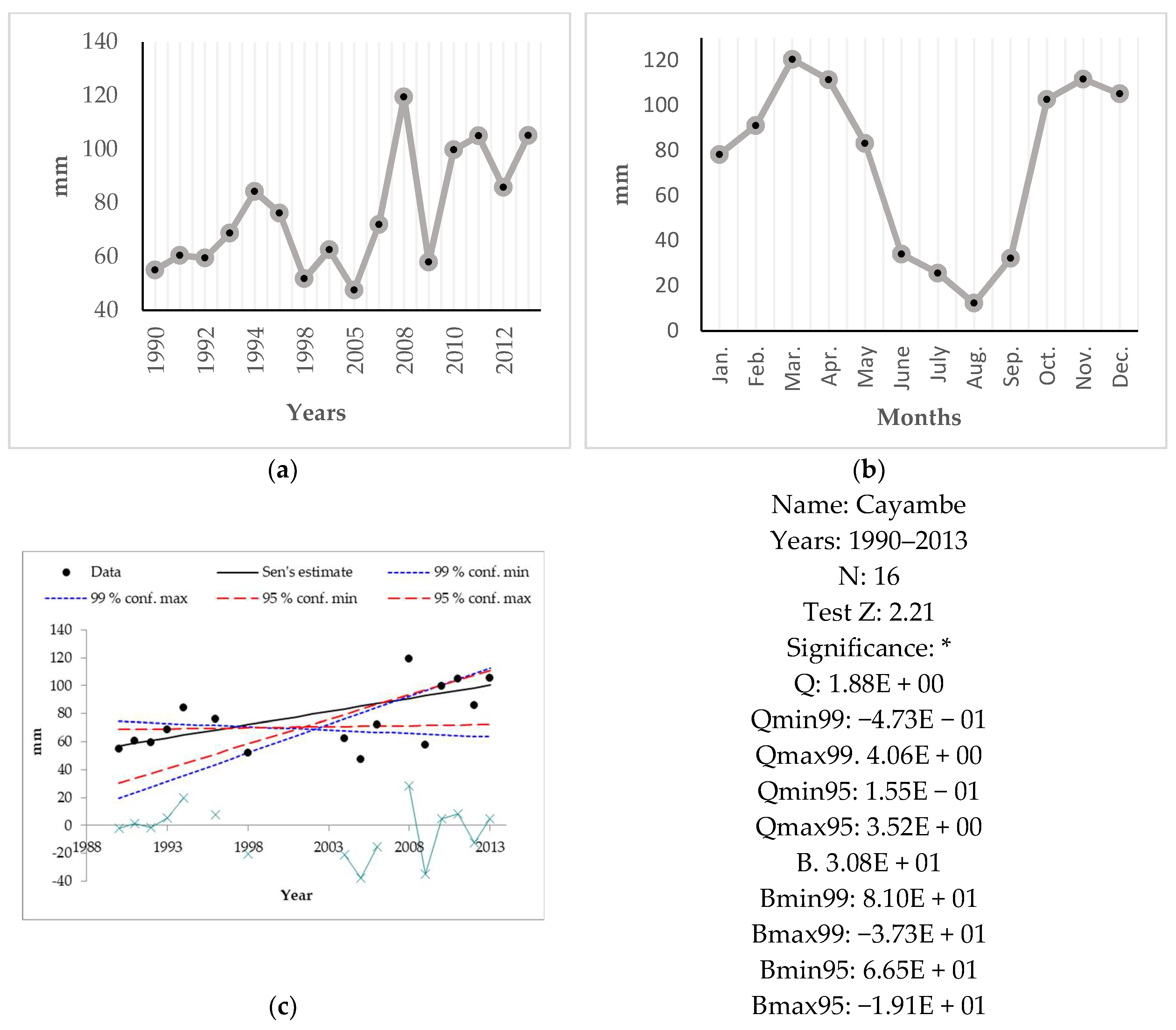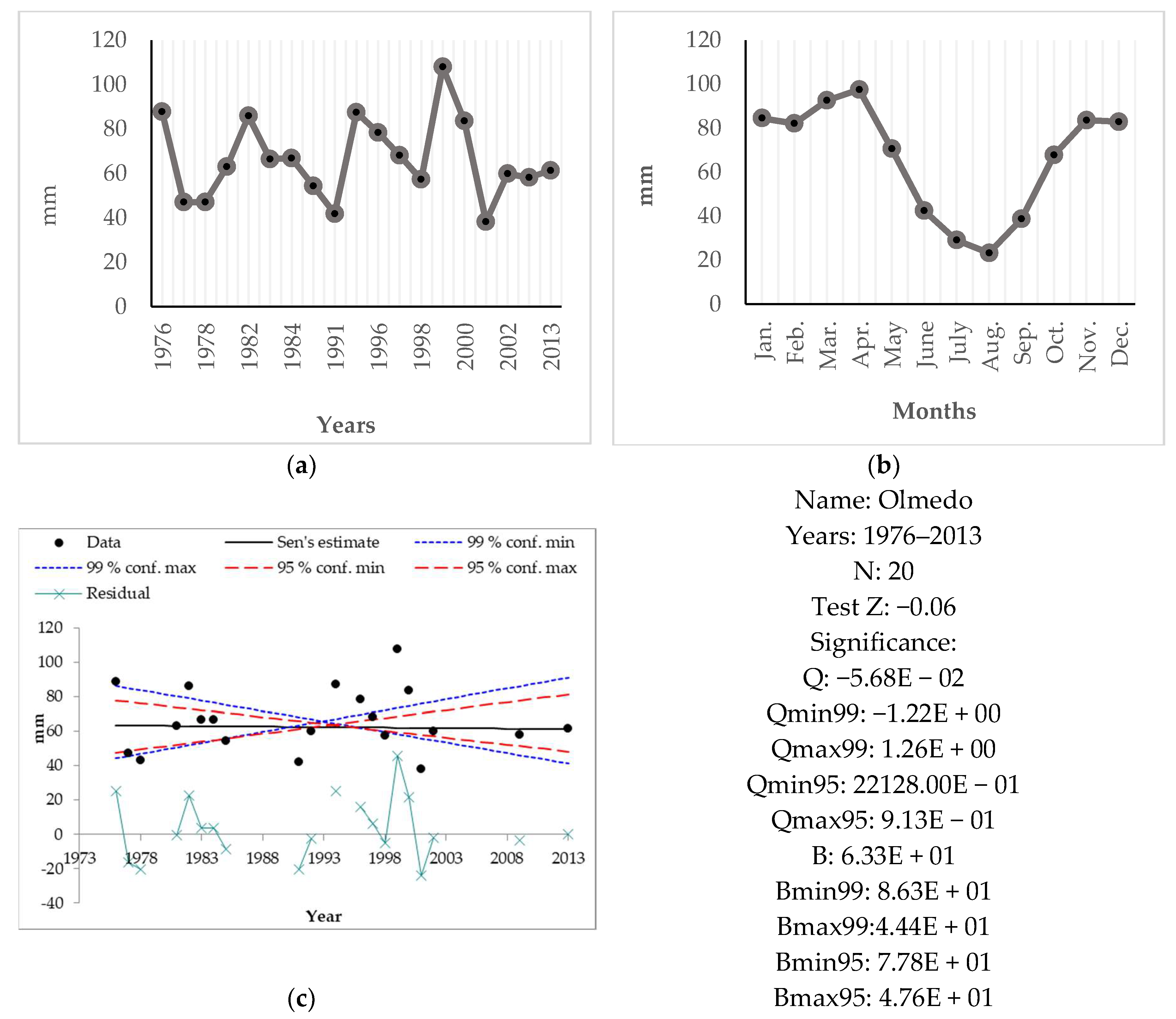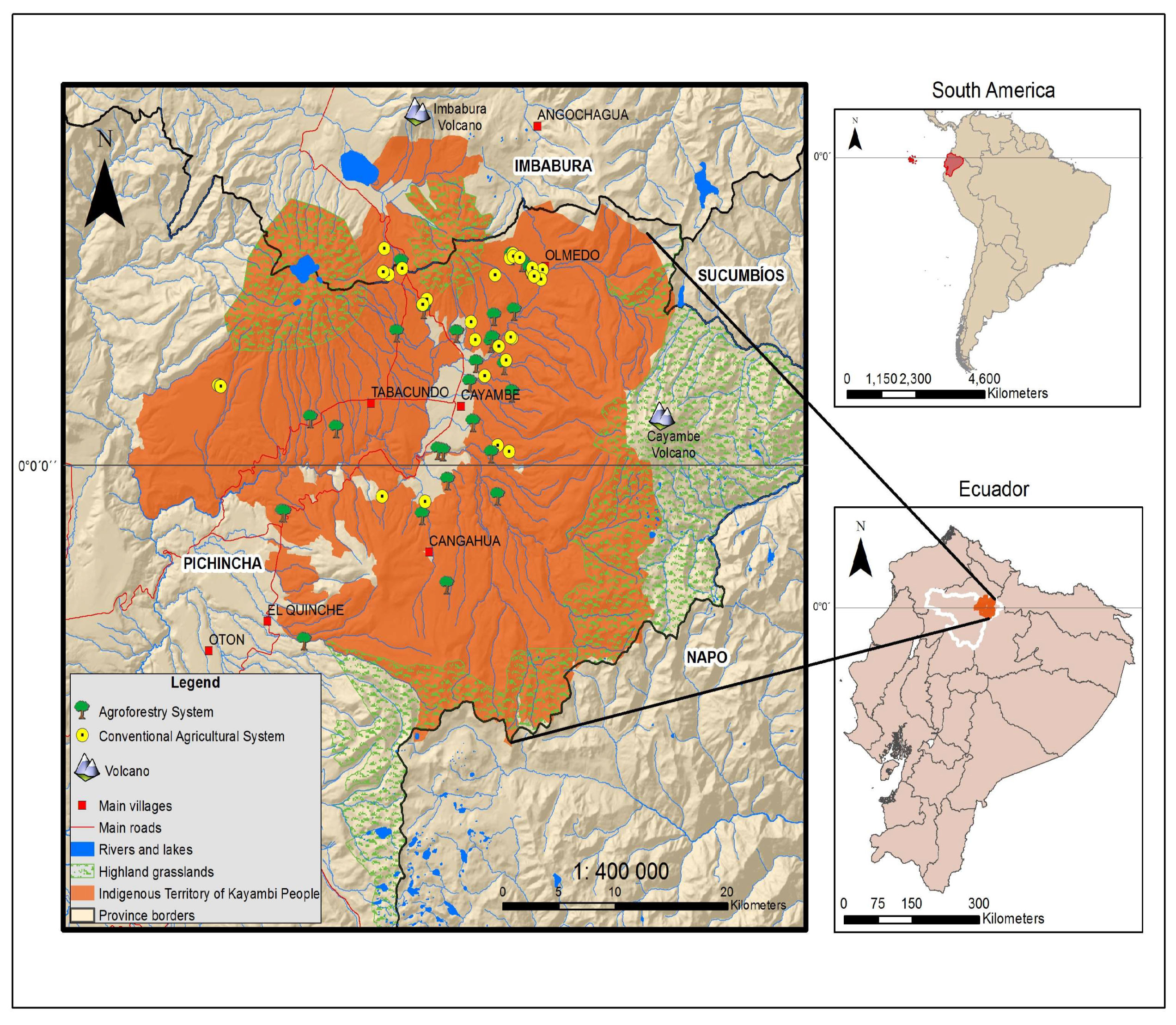4.1. Exposure
Even though the perceptions of exposure to CCV in this study did not show a difference between AFS and CAS (
Table 1), some perceptions differ, and others are aligned with last decade’s observations and future climatic changes and extreme events scenarios. The perceptions of both agroforesters and conventional farmers indicate a clear exposure of their systems to temperature increases in all seasons throughout the year for the last and next decade. Temperature increase perceptions coincide with documented observations and projected trends according to different climate change scenarios for northern and Tropical Andes [
17,
21,
22,
44,
45]. In the case of precipitation, the smallholder farmers in both production systems perceive a clear precipitation reduction trend throughout the year for the last decade, and expect the same trend to continue for the next decade. Perceptions on precipitation reduction differ from the observed and projected precipitation changes for the Andean region, which mostly indicate an increase in precipitation during recent decades and for future scenarios [
17,
21,
44,
46,
47]. The difference in precipitation changes between smallholder farmers’ perceptions and observed/projected changes (reported also in local studies for the Northern Andes) are, however, not reliable due to the multitude of microclimates in the region (influenced by internal variability/seasonality, the yearly and decadal variation of El Niño Southern Oscillation (ENSO) and the Pacific Decadal Oscillation (PDO) [
20,
48]) and the difficulty/inaccuracy of applying averages. The changes in precipitation are less evident than changes in temperature [
44], and in the case of the Andes these changes are even less noticeable when there is a lack of long and high-quality precipitation records to establish long-term trends [
20,
49]. On the other hand, the smallholder farmers’ perceptions on temperature and precipitation changes in the study area are aligned with local observations and projections as indicated in other studies, showing trends of annual temperature increases (+1.4 to +2.4 °C) and annual precipitation reductions in Ecuadorian Northern Andes and areas around the equator (−5% to −20%) [
50,
51,
52,
53].
Despite the lack of long-term and high-quality records of precipitation and temperature in the study area,
Figure A1,
Figure A2,
Figure A3 and
Figure A4 in
Appendix B show the available temperature and precipitation data from basic meteorological stations along the study area. These data—collected by the National Institute of Meteorology and Hydrology (INAMHI) as part of the national meteorological network—were useful to compare the perceptions of farmers and real measurements, in order to establish if the perceptions correspond to actual changes in climate or if they only represent perceptions of climatic variability. In that sense the Mann–Kendall test and Sen’s slope estimations, shown in
Figure A1c,
Figure A2c, and
Figure A4c in
Appendix B, indicate that there are not clear trends for temperature and precipitation. Only in the case of precipitation at Cayambe station (
Figure A3c), the Mann–Kendall test and Sen’s slope estimation indicate an upward trend (at 0.05 level of significance), coinciding with the scientific observations of precipitation increases observed/predicted for the Tropical Andes Region. The lack of clear temperature and precipitation trends for most of the available time series in the study area, may be due to the very limited and fragmented data available, reducing the accuracy of the Mann–Kendall test and Sen’s slope estimations. Thus, the trends perceived by farmers in this study may be related to the inter-annual variability (between the years) or the intra-annual variability (between the seasons), as it is clearly observed in the inter-annual and intra-annual variability on precipitation (
Figure A2a,b,
Figure A3a,b,
Figure A4a,b in
Appendix B).
The results about smallholder farmers’ perceptions on ECE and other related climate events occurrence (
Table 1), during the last and next decade, did not show significant differences between systems, indicating also interesting coincidences and differences with the observed and projected events by science. Perceptions of heavy rainfall reductions are similar to observations and projections indicated in many Andean region studies (about three days above 10 mm per decade) [
17,
54], with some logical connection with the perceptions of annual and seasonal precipitation reductions stressed above. The reduction of hail events perceived by agroforesters and conventional farmers could be seen as a positive change due to the reduced crop damage when these events take place. It is, however, very difficult to compare perceptions of hail events and real observations due to the lack of long-term and consistent observations in the study area. Some recent studies from other regions on the influence of climate change on the frequency of hailstorm events indicate some similarities with the perceptions of smallholder farmers in this study. For example, hail event reductions and increased hail damage potential due to an increase in hail size were reported and projected for some parts of North America [
55], while reductions in hail size and events were measured over China [
56]. In the case of the Andean region, some inner tropics studies also report a decrease of hail events during recent decades [
57], while outer tropics studies indicate both increases and reductions in the number of hailstorm events without consistent trends, and also highlight the site-specific dependence (region, topography, altitude, latitude, longitude) of this type of climatic event [
58,
59,
60,
61]. Furthermore, although farmers’ perceptions about increased incidence of heavy windstorms, droughts/dry periods, and heat waves/warm periods are clearly aligned with scientific observations and projections [
17,
20,
22,
54,
62,
63,
64], the perceptions of cold periods/frost increments differ with scientific observations and projections, which show a robust reduction [
17,
21,
45,
54].
Among the other climate-related events shown in
Table 1, the perception of glacial retreat is the most interesting and controversial. Although most agroforesters and conventional farmers did not perceive important changes related to the Cayambe glacier mass retreat during the last and next decade, a significant proportion of conventional farmers (33%) perceived a retreat process, while only 10% of agroforesters perceived the same process (
Table 1). Considering that the retreat of tropical glaciers, accelerated during ENSO periods, represents such strong evidence of global warming [
17,
21,
44,
49,
59,
65,
66], the results in this study are a surprising and unexpected result. The stable Cayambe glacier mass condition perceived by most of the farmers is not aligned with the retreat process indicated in some studies [
67,
68], which report a decrease between 25% and 48% of the glacier area during last decades (1979–2009). The lack of awareness about the Cayambe glacier retreat showed by farmers, may be explained by the lack of perceptible events and impacts related to the deglaciation process (
Table 4).
Even though the perceptions of agroforesters and conventional famers about the trends of the main gradual climate changes, extremes, and other climate-related events affecting their production systems are practically the same (
Table 1), the number and type of the affecting climate and non-climate stressors show important differences and similarities between systems (
Table 2). The greater exposure perceived by conventional farmers, shown in the more complex CCRS categories (formed by five and six stressors) and the greater incidence of specific stressors, especially droughts, radiation and PWD outbreaks (
Table 2), suggests that CAS are more vulnerable to CCV than AFS. The lower exposure for AFS support the findings of other studies suggesting that production systems with agroecological approaches, including agroforestry, tend to be less vulnerable to the negative effects of climate change, extremes and other climate-related events described above [
69,
70,
71,
72]. It is important to note that the greater radiation exposure indicated by conventional farmers (and perceived mainly as the heat stress suffered by farmers and animals during farming activities) is one of the less studied climate stressors, which will have important consequences in the productivity of the systems and in farmers’ health [
18,
73]. Furthermore, the less radiation/heat stress perceived by agroforesters may be explained by the favorable shade and environmental conditions (buffering functions) provided by trees and shrubs in these type of systems [
69]. Considering the lack of data about ultraviolet radiation exposure and heat stress-related illnesses in agricultural workers worldwide, and the fact that the studied production systems are located in equatorial highlands (2500–3300 m.a.s.l) where the ultraviolet radiation index (UVI) measurements are probably the highest on the planet [
74,
75], the solar radiation increase reported by farmers in this study is an important subject for further research due to its influence on productivity and farmers’ health. Some farmers in this study have already indicated that the exposure to stronger solar radiation and hot temperatures are increasing the cases of heat exhaustion, sunburn, and the chronic effects on the skin and eyes, such as photoaging, cortical cataract, and pterygium. These are common disorders reported in other studies and specialized literature that emphasize the increase of skin cancers worldwide and in the Andean region [
73,
74,
76,
77,
78].
4.2. Sensitivity
Farmers’ perceptions about the sensitivity of the main biophysical components of the farming systems (soil, water, and biodiversity) to the impacts of ECE and gradual climate changes indicate that AFS are less sensitive than CAS to negative impacts. Furthermore, AFS have better capacities to control land and soil degradation, including erosion control, chemical and physical deterioration of soil and the biological and water degradation of the system (
Table 3). Taking into consideration that water and wind erosion are the most common drivers for soil deterioration worldwide (including Ecuador and the study area [
50,
79,
80,
81]), and that soil deterioration processes will be enhanced by the influence of CCV and ECE, the better capacity of AFS to control land and soil degradation represent important advantages in the maintenance of soil fertility (a basic requirement to guarantee the system’s productivity and food security of smallholder farmers’ households in developing countries [
82]). It is also important to remark that the warmer conditions and the changes in precipitation regimes observed and expected for the Andes and other mountain regions are accelerating decomposition and reducing soil organic matter [
83,
84], one of the key soil fertility components. Therefore, the greater capacity showed by AFS to increase soil organic matter and nutrient availability/supply/recycling (
Table 3) represents a significant contribution towards maintaining soil fertility and reducing vulnerability to CCV. The greater contribution of soil organic matter and nutrient availability perceived by agroforesters in this study support the findings of other studies that show how organic and agroecological farming systems, included AFS, contain higher soil organic matter content and lower nutrient losses per unit area than conventional systems [
85,
86]. In the case of physical properties of soils, the perceptions of agroforesters highlighted the better conditions of AFS to improve the texture and structure of top/subsoil, thereby contributing to less crusting, sealing, compaction, and hardpan problems. It is also interesting to note that the positive influence of agroecological practices and the incorporation of tress/shrubs in AFS is reflected in the more positive agroforesters’ perceptions on soil stabilization and infiltration properties than conventional farmers (
Table 3). The perceived ability of AFS in reducing compaction and improving texture, structure and infiltration of top/subsoil, will also contribute to maintain soil fertility, enhancing the physical and chemical soil processes (such as mass flow, diffusion of water, ions and gases), avoiding wind and water erosion, and reducing the emission of greenhouse gases (such as CO
2, CH
4 and N
2O); common benefits attributed to well-structured and non-compacted soils [
87].
Among the biophysical controlling factors considered in the evaluation of production systems’ sensitivity in this study, the processes included in the control of biological degradation show the greater positive influence in the perceptions of agroforesters compared to conventional farmers (
Table 3). Taking into consideration that global warming and climate change are contributing to the acceleration of processes related to biodiversity and agrobiodiversity loss at local, regional, and global levels [
88,
89,
90,
91,
92,
93], the greater agrobiodiversity of AFS are important advantages to reduce the vulnerability, maintain the functionality of systems, enhance food security of households, and therefore increasing the overall systems’ resilience [
89,
94,
95,
96]. The higher number of perceptions about the positive influence of AFS in avoiding biological degradation and promoting agrobiodiversity could be related to the greater cultivated and associated agrobiodiversity (in number of species, varieties and breeds) found for the same AFS in our previous paper [
23]. It is important to remark that among the biological degradation factors presented in
Table 3, the greater capacity of AFS to increase pest control and beneficial species, and reduce invasive alien species, represent undeniable advantages to maintain food security and yields, through reducing vulnerability to pests/diseases attacks and expansion, which are well documented problems expected to be intensified by global warming and CCV [
12,
17,
97,
98].
Finally, AFS in this study show better capacity to control water degradation than CAS, especially through increasing/maintaining water stored in soil, improving water harvesting/collection, reducing evaporation and supporting water spreading (
Table 3). Taking into account that scientific observations and projections for the Tropical Andes indicate less and more erratic precipitation, temperature and evapotranspiration increases, and longer drought periods [
12,
17,
20,
21,
50,
54,
98], the greater capacity of AFS to maintain and enhance water availability represents a fundamental advantage to reduce sensitivity and vulnerability of these systems to the predicted warmer and dryer conditions. The findings in this study of better water degradation control for AFS are consistent with other studies stressing the greater drought resilience and soil water-holding capacity of AFS compared to conventional systems [
85]. In addition, the less vulnerability and the better water availability presented for AFS in this study could be enhanced by the greater access and diversification of irrigation sources indicated for the same AFS in our previous study [
23]. The results clearly indicate that AFS are less sensitive at the farm level than CAS to the impacts of CCV, confirming the findings of other studies and extensive literature related to the better socioeconomic and environmental capacities of these systems to deal with gradual climate changes and extremes.
From the 50 attributes and processes considered for on-site impacts (farm level) in
Table 2, the majority of them (44 attributes and processes) do not show any negative effects in the case of AFS, suggesting even more positive effects on the functionality of these systems. In contrast, CAS show greater negative effects and therefore higher sensitivity. The same tendency is found also in the socioeconomic and ecological components, being more remarkable among most of the ecological attributes and processes than in the socioeconomic component. Even though there is not a well-defined tendency of the impact levels among the sociocultural attributes and processes, the smallholder farmers perceptions suggest fewer negative impacts on the functionality of AFS. For example, cultural and recreational opportunities, traditional knowledge conservation, food security/self-sufficiency (dependence on external support) and health are not impacted by and CCRS, showing even more positive effects than in CAS. Conflicts have been impacted negatively in both systems, while community institution strengthening is positively impacted. Complementary to this, the position of socially and economically disadvantaged groups (gender, age, status, ethnicity, etc.) is not influenced or impacted in either system.
The reductions in the productivity of major crops (caused mainly by global warming and rain pattern changes) observed and projected for the tropics, are negatively influencing the livelihoods of farmers [
12,
18,
97,
99]. Therefore, farming systems that maintain and improve productivity will constitute the most suitable systems to guarantee food security and reduce poverty of millions of smallholder farmers. The lower sensitivity showed by AFS among key socioeconomic attributes and processes related to the system’s productivity (
Table 4) represents a very important advantage in reducing the system’s vulnerability and increasing resilience to CCV. In addition, the better ability of AFS in maintaining and enhancing system’s productivity could be seen as an important element to guarantee the food security of smallholder agroforesters’ households. The better figures (indicating no impacts with more positive effects on AFS) perceived on the socioeconomic attributes and processes related to smallholder farmers’ livelihoods (
Table 4), represents a greater competitive advantage to enhance agroforesters’ livelihoods and reduce poverty, common problems intensified by CCV [
18].
Water availability and quality were also taken into account as key socioeconomic attributes influencing the systems’ productivity (irrigation water) and households’ welfare (drinking water). In that sense the less irrigation and drinking water availability/quality perceived by conventional farmers, suggest a greater vulnerability than in the case of agroforesters. Additionally, both agroforesters and conventional farmers perceived that CCRS have increase the demand of irrigation water (
Table 4). These perceptions are consistent with global and regional studies (Tropical Andes) that indicate reductions in the availability and quality of water resources, especially in upland communities, and an increase in irrigation water demand, mainly due to temperature increase, precipitation patterns changes, glacial retreat and wetland damage [
9,
11,
17,
20,
21,
44,
83,
100]. It is important to add that the non-effect perceived by agroforesters on the availability/quality of irrigation water could be related to the better access and diversification of irrigation sources, as was found for AFS in our previous paper [
23].
It is important to consider the negative and positive effects of CCRS in the context of some key sociocultural aspects. The reduction of cultural and recreational opportunities, especially in the case of conventional farmers, are already affecting the participation of farmers in important traditional ceremonies related to their agricultural calendar. Farmers have mentioned that CCV, especially the reduction and changes in precipitation regimes, and the more frequent drought periods, are affecting the sowing and harvesting seasons, reducing the yields of traditional crops (mainly potatoes and maize). Due to yield reductions and the increase of poverty, farmers are not motivated to participate in the celebrations, especially the harvest celebration know as Inti Raymi (Sun festival) in the Andes Region, and as San Pedro´s festivity by the Kayambi People. These celebrations include the sharing of harvest with relatives and other community members [
101,
102,
103]. In the case of conflicts, farmers in both system types indicate that conflicts related to water resources have increased between communities and other users. Water sharing conflicts are more frequent during long drought periods. Agroforesters and conventional farmers’ perceptions of conflict increase for water resources are consistent with perceptions and studies on water availability reductions indicated at landscape level (
Table 4) and for Tropical Andes. The deterioration of health conditions, perceived mostly by conventional farmers, are mainly related to temperature and solar radiation increase. Farmers complain that higher temperature and radiation are increasing the cases of heat exhaustion, skin, and eye disorders, as was mentioned and reported by other literature as discussed in the exposure
Section 4.1.
Recreational opportunities, traditional/indigenous knowledge conservation, and food security/self-sufficiency also represent important sociocultural aspects, which are without impacts in the case of AFS, but negatively affected in the case of CAS. Recreational opportunities for most of the farmers in this study (more than 70% women) are understood as the opportunities to spend time doing their favorite activities at the farm. Farmers mentioned that their hobby is farming. In that sense, the better recreational opportunities indicated by agroforesters are consistent with their better perceptions on labor constraints, workload and difficulty of farm operations (
Table 4). Considering that traditional/indigenous knowledge is one of the key aspects to enhance smallholder farmers’ adaptation and resilience [
9,
12,
17,
20,
98], the lower effects of CCRS on traditional knowledge conservation indicated by agroforesters may suggest that these farmers have a crucial sociocultural asset to cope and deal with CCV. On the other hand, the decline of traditional/indigenous knowledge conservation perceived by most conventional farmers suggest a loss of important traditional approaches and land management techniques to reduce vulnerability, as has been reported in other literature [
12,
98,
104,
105].
Taking into consideration that smallholder farmers’ food security/self-sufficiency, including food access, use, and price stability, constitutes one of the most negatively affected aspects by CCV, especially in low-latitude developing countries [
9,
12,
17,
98]. The more positive perceptions by AFS in this regard constitute a relevant advantage to maintain/enhance smallholder farmers’ sustainable livelihoods and reduce the vulnerability to CCV. Most agroforesters perceived that CCRS do not affect their food security, with even a more positive effect in contrast of conventional farmers’ perceptions, which indicate a consistent negative effect on their food security. In addition, recent studies indicate that climate variability and extremes, especially severe droughts, are highly connected with the recent rise in global hunger, being also one of the leading causes of severe food crises. Currently, droughts are responsible for more than 80% of the total damage and losses in global agriculture, especially for the livestock and crop production subsectors [
106]. In that sense the lower exposure to droughts for AFS (
Table 2) represents an important resilience advantage of these systems compared with CAS. Finally, the no affect perceived by most of agroforesters and conventional farmers on the position of socially and economically disadvantaged groups (gender, age, status, ethnicity, etc.) may suggest that the impacts of CCRS are not yet so evident among specific social groups, or that the farmers in this study (most of them indigenous women) are not aware of the impacts of CCV on specific vulnerable social groups within the community. These perceptions are not consistent with studies indicating that in most developing countries, women and young children can be particularly vulnerable to climate variability and extremes, as can the elderly and socially isolated [
9,
17,
106]. Studies also stress that the prevalence of severe food insecurity is slightly higher among women, with the largest differences found in Latin America [
106].
The analysis of the impact level of CCRS in the ecological component show that most of AFS’ attributes and processes are less sensitive to the impacts of CCV than in the case of CAS (
Table 4). Most of the agroforesters’ perceptions indicate a clear tendency of no affect, and show more positive influence of the main CCRS among the ecological component. On the contrary, conventional farmers indicate mostly negative effects on their systems. Thus, the more positive perceptions of the AFS in aspects related to water, soil, and biodiversity conservation in
Table 4, could be associated with the greater biophysical controlling factors indicated also for AFS in
Table 3, supporting the worldwide assumption that AFS are one of the most promising land-use management systems for water, soil and biodiversity conservation and enhancement [
69,
107,
108,
109,
110]. These represent essential production systems’ elements to be negatively affected and exacerbated by global warming and CCV, especially in the Andes and other mountain regions [
11,
17,
84,
100,
111]. In addition, it is important to remark that CAS show higher vulnerability in key water-related attributes, such as the reduction in water quantity, quality, soil moisture, and increased evaporation. These perceptions are also aligned with current and projected impacts indicated in the literature, especially for mountains and the Tropical Andes [
11,
17,
20,
98,
112].
The similar farmers’ perceptions on the sensitivity of the landscape to the impacts of the main CCRS (off-site impacts in
Table 5), highlight a common tendency related to the availability and quality of water resources. Water availability and supply are already considered an important problem at the landscape level, especially in the dry season. Less water availability and low flows perceived by agroforesters and conventional farmers are aligned with perceptions on reductions of sediment yields, downstream flooding, and increases in groundwater/river pollution (
Table 5). It is interesting how wind erosion aspects (wind speed in
Table 3 and wind transported sediments in
Table 5) are perceived differently at the farm and landscape levels. Whereas most agroforesters perceived that their farming system approach is very important to control wind erosion at the farm level, and vice versa in the case of conventional farmers (
Table 3), the negative effects of wind erosion at the landscape level are similarly perceived by agroforesters and conventional farmers (
Table 5). Considering that many studies show that expected dryer conditions caused by CCV will intensify wind erosion processes [
11,
82,
97,
98,
113,
114], the perceptions described above could confirm the extended assumptions that AFS have better capacities than other productive systems to control wind erosion at the farm level, as well as having enormous potential to control erosion at the landscape level [
69,
85,
108,
114,
115]. Finally, the ”no damage on neighbors’ field” and on ”public/private infrastructure” perceived by agroforesters and conventional farmers (
Table 4), suggest that the CCRS, especially extreme events, do not have destructive impacts either at the farm or landscape levels. These perceptions are aligned with the exposure perceptions (
Table 1) related to reductions of some destructive extreme events such as heavy rainfall/hail events, or the lack of perceived glacier retrieve, floods, thunderstorms, and fires. On the other hand, the “no damage” perceptions indicated above do not reflect the potential damages caused by the high exposure to heavy winds, drought/dry periods, heat waves/warm periods and cold periods/frost, perceived in
Table 1, suggesting that these extremes do not yet have the destructive effects on the farming systems and landscape.
